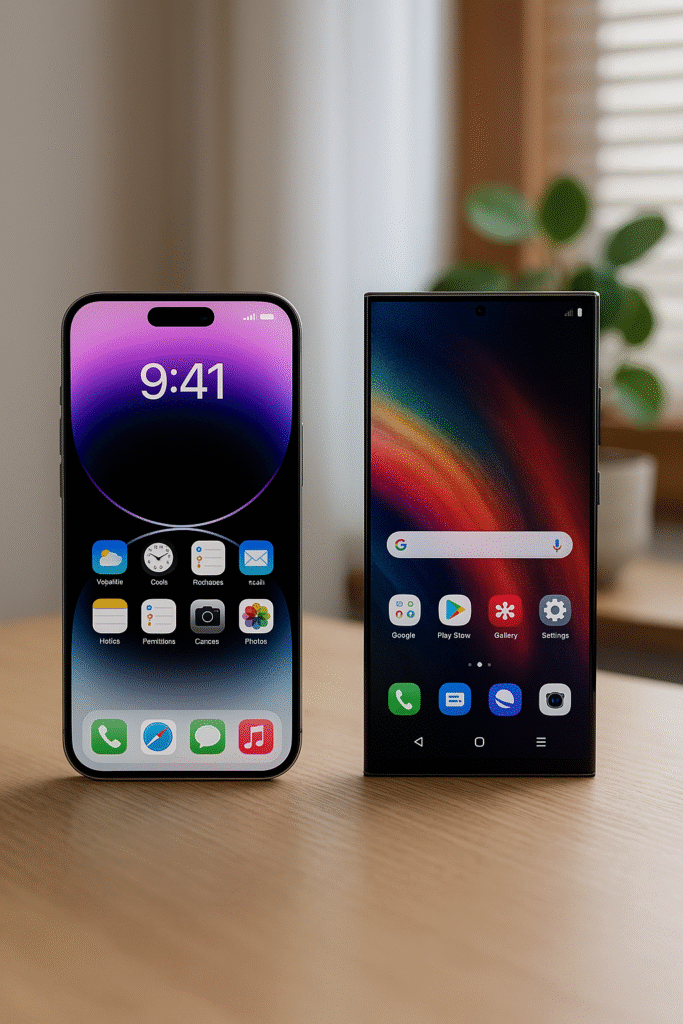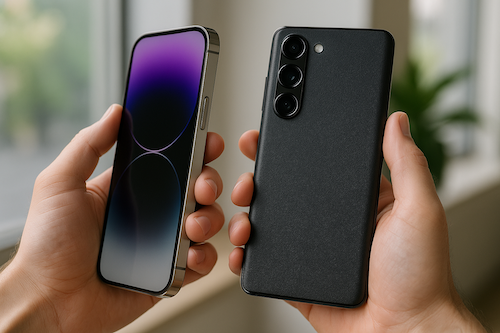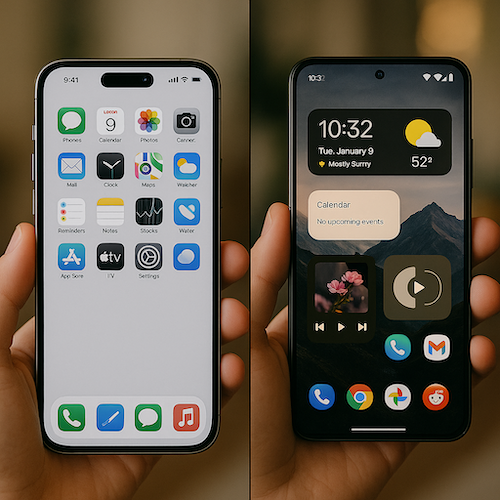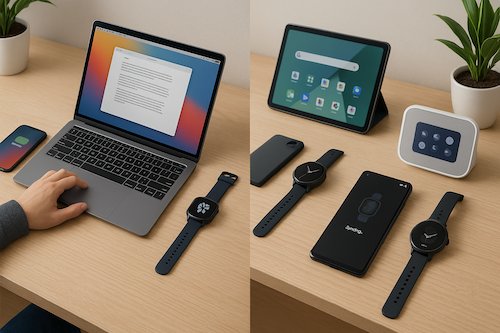iPhone vs Android Flagships – A Complete Look
The debate between iPhone and Android flagships has been a hot topic among tech enthusiasts for years. With each new generation, both sides push the limits of design, performance, and innovation. In this comprehensive guide, we’ll dive into every aspect of flagship smartphones—from design and hardware to software and ecosystem integration—to help you determine which platform might be the best fit for your needs.
Design and Build Quality
iPhone Flagships:
Apple is renowned for its meticulous design and premium build quality. iPhones typically feature a sleek, minimalist design with materials like aerospace-grade aluminum, stainless steel, and durable glass. Their design language emphasizes uniformity and ease of use, contributing to a refined, high-end look.
Android Flagships:
Android manufacturers offer a diverse range of designs, from the premium glass and metal builds of the Samsung Galaxy series to the more experimental designs of brands like OnePlus and Xiaomi. This diversity means you can choose a design that not only fits your aesthetic but also offers features like customizable modules and various form factors.
Performance and Hardware
iPhone Flagships:
Powered by Apple’s in-house A-series chips, iPhones consistently deliver top-notch performance. These chips are optimized for energy efficiency and integrated seamlessly with iOS, ensuring smooth multitasking, gaming, and overall responsiveness. The integration of hardware and software in iPhones leads to a consistently fluid user experience.
Android Flagships:
Android flagships, on the other hand, often utilize the latest Qualcomm Snapdragon or Exynos processors, delivering impressive performance, especially in multitasking and gaming. With higher RAM options and advanced hardware configurations, many Android devices excel in scenarios where raw power and flexibility are required. The performance gap has narrowed considerably, making the competition fierce.
Software and User Experience
iOS (iPhone):
iOS is celebrated for its clean interface, intuitive navigation, and consistency across devices. Regular software updates ensure that even older iPhone models receive the latest features and security patches. The controlled ecosystem guarantees a uniform experience, making it easy for users to transition between Apple devices.
Android:
Android’s strength lies in its flexibility and customization options. Users can tailor their home screens, widgets, and overall interface to suit their preferences. Different manufacturers add their own skins (like Samsung’s One UI or Xiaomi’s MIUI) to the base Android experience, providing unique features and customizations. However, this diversity can sometimes lead to fragmentation in software updates.
Camera Capabilities
iPhone Flagships:
iPhones are known for their consistent camera performance, excellent color reproduction, and reliable video quality. Advanced computational photography and video stabilization make them a favorite among creators. Features like Night mode, Deep Fusion, and 4K video capture contribute to a well-rounded photography experience.
Android Flagships:
Android devices often lead in camera innovation, offering high megapixel counts, versatile lens options (wide, ultra-wide, telephoto), and innovative features like periscope zoom. Brands like Samsung and Google push the boundaries with AI-powered enhancements, ensuring that photos and videos remain sharp, vibrant, and adaptable to various lighting conditions.
Battery Life and Charging
iPhone Flagships:
iPhones usually offer a balanced approach to battery life, optimized through tight integration with iOS. While they may not always feature the highest battery capacities on paper, efficiency improvements in software and hardware often result in reliable all-day performance. Wireless charging and fast charging capabilities are steadily improving with each generation.
Android Flagships:
Android devices often pack larger batteries, and many offer fast-charging technologies that can significantly reduce downtime. Additionally, wireless charging and reverse charging features are common, allowing Android users to charge other devices on the go. However, battery performance can vary widely among different models and brands.
Ecosystem and Software Updates
iPhone Ecosystem:
Apple’s ecosystem is one of its strongest selling points. With seamless integration across iPhone, iPad, Mac, Apple Watch, and Apple TV, users enjoy a cohesive experience that enhances productivity and convenience. Regular and long-term software updates ensure security and access to new features for several years.
Android Ecosystem:
The Android ecosystem is more fragmented due to the variety of manufacturers. However, it offers flexibility and integration with a wide range of smart devices, including wearables, smart home products, and even vehicles. Google’s ecosystem, combined with manufacturer-specific services, provides a rich experience, though the frequency and duration of software updates may vary.
Price and Value Proposition
iPhone Flagships:
iPhones are positioned as premium devices, often carrying a higher price tag. Their value proposition includes build quality, long-term software support, and a robust ecosystem. For many users, the investment in an iPhone is justified by its performance and longevity.
Android Flagships:
Android flagships span a broader price range, with options available at various price points. Many Android manufacturers offer flagship-level features at a lower cost compared to iPhones, making them attractive for users who seek high-end performance without a premium price. The competitive market drives innovation and affordability across the board.
Security and Privacy
iPhone Flagships:
Apple places a strong emphasis on privacy and security. With features like Face ID, secure enclave, and strict app vetting, iPhones are built to protect user data. Regular security updates and a controlled ecosystem further contribute to a secure user experience.
Android Flagships:
Android devices incorporate robust security measures as well, including biometric authentication and encryption. However, due to the open nature of the platform and varying update schedules across manufacturers, security can sometimes be less consistent compared to iOS. Google has been actively working to enhance Android’s security framework in recent years.
Innovation and Unique Features
iPhone Flagships:
Apple is known for its incremental innovation—refining and perfecting existing technologies. Features like the seamless integration of hardware and software, advanced AR capabilities, and a focus on user privacy set iPhones apart.
Android Flagships:
Android manufacturers often experiment with bold innovations. Whether it’s foldable displays, ultra-fast charging, or cutting-edge camera systems, Android flagships frequently introduce new concepts that redefine what smartphones can do. This willingness to experiment appeals to early adopters and tech enthusiasts.
Final Thoughts: Which Is Right for You?
Ultimately, the choice between an iPhone and an Android flagship comes down to personal preferences and priorities. If you value a seamless ecosystem, long-term software updates, and a polished, consistent experience, an iPhone might be the best fit. On the other hand, if you prefer customization, a wider range of hardware options, and potentially more competitive pricing, an Android flagship could be the way to go.
Both platforms continue to push the boundaries of what smartphones can achieve, ensuring that regardless of your choice, you’ll be investing in a device that’s at the forefront of technology.
Conclusion
The ongoing battle between iPhone and Android flagships is a testament to the dynamic nature of the tech industry. With each platform offering its own unique strengths—from design and performance to camera quality and ecosystem integration—there is no one-size-fits-all answer. This complete look has provided you with a thorough understanding of the key factors that differentiate these leading smartphones. Armed with this information, you can now make an informed decision that best aligns with your lifestyle, budget, and technological preferences. Happy shopping, and may your new flagship device elevate your digital experience!









Leave a Reply
Want to join the discussion?Feel free to contribute!